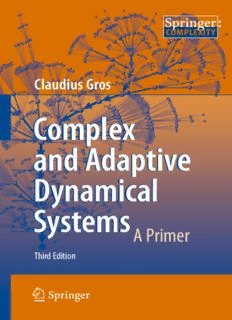
Complex and Adaptive Dynamical Systems: A Primer PDF
Preview Complex and Adaptive Dynamical Systems: A Primer
3 COMPLEXITY Claudius Gros CCoommpplleexx aanndd AAddaappttiivvee DDyynnaammiiccaall SSyysstteemmss A Primer Third Edition 123 Springer Complexity Springer Complexity is an interdisciplinary program publishing the best research and academic-level teaching on both fundamental and applied aspects of complex systems – cutting across all traditional disciplines of the natural and life sciences, engineering, economics,medicine,neuroscience,socialandcomputerscience. Complex Systems are systems that comprise many interacting parts with the ability to generate anew qualityof macroscopic collectivebehavior themanifestations of whichare the spontaneous formation of distinctive temporal, spatial or functional structures. Models of such systems can be successfully mapped onto quite diverse “real-life” situations like theclimate,thecoherentemissionoflightfromlasers,chemicalreaction-diffusionsystems, biologicalcellularnetworks, thedynamicsofstockmarketsandoftheinternet,earthquake statistics and prediction, freeway traffic, the human brain, or the formation of opinions in socialsystems,tonamejustsomeofthepopularapplications. Although their scope and methodologies overlap somewhat, one can distinguish the following main concepts and tools: self-organization, nonlinear dynamics, synergetics, turbulence,dynamicalsystems,catastrophes,instabilities,stochasticprocesses,chaos,graphs and networks, cellular automata, adaptive systems, genetic algorithms and computational intelligence. ThethreemajorbookpublicationplatformsoftheSpringerComplexityprogramarethe monograph series“Understanding ComplexSystems”focusing on thevariousapplications of complexity, the “Springer Series in Synergetics”, which is devoted to the quantitative theoreticalandmethodological foundations,andthe“SpringerBriefsinComplexity”which are concise and topical working reports, case-studies, surveys, essays and lecture notes of relevance to the field. In addition to the books in these two core series, the program also incorporatesindividualtitlesrangingfromtextbookstomajorreferenceworks. EditorialandProgrammeAdvisoryBoard HenryAbarbanel,InstituteforNonlinearScience,UniversityofCalifornia,SanDiego,USA DanBraha,NewEnglandComplexSystemsInstituteandUniversityofMassachusettsDartmouth,USA Pe´ter E´rdi, Center for Complex Systems Studies, Kalamazoo College, USA and Hungarian Academy ofSciences,Budapest,Hungary KarlFriston,InstituteofCognitiveNeuroscience,UniversityCollegeLondon,London,UK HermannHaken,CenterofSynergetics,UniversityofStuttgart,Stuttgart,Germany Viktor Jirsa, Centre National de la Recherche Scientifique (CNRS), Universite´ de la Me´diterrane´e, Marseille,France JanuszKacprzyk,SystemResearch,PolishAcademyofSciences,Warsaw,Poland KunihikoKaneko,ResearchCenterforComplexSystemsBiology,TheUniversityofTokyo,Tokyo,Japan ScottKelso,CenterforComplexSystemsandBrainSciences,FloridaAtlanticUniversity,BocaRaton, USA Markus Kirkilionis, Mathematics Institute and Centre for Complex Systems, University of Warwick, Coventry,UK Ju¨rgenKurths,NonlinearDynamicsGroup,UniversityofPotsdam,Potsdam,Germany AndrzejNowak,DepartmentofPsychology,WarsawUniversity,Poland LindaReichl,CenterforComplexQuantumSystems,UniversityofTexas,Austin,USA PeterSchuster,TheoreticalChemistryandStructuralBiology,UniversityofVienna,Vienna,Austria FrankSchweitzer,SystemDesign,ETHZurich,Zurich,Switzerland DidierSornette,EntrepreneurialRisk,ETHZurich,Zurich,Switzerland StefanThurner,SectionforScienceofComplexSystems,MedicalUniversityofVienna,Vienna,Austria Claudius Gros Complex and Adaptive Dynamical Systems A Primer Third Edition 123 Prof.Dr.ClaudiusGros Universita¨tFrankfurt Institutfu¨rTheoretischePhysik Frankfurt Germany ISBN978-3-642-36585-0 ISBN978-3-642-36586-7(ebook) DOI10.1007/978-3-642-36586-7 SpringerHeidelbergNewYorkDordrechtLondon LibraryofCongressControlNumber:2013936648 (cid:2)c Springer-VerlagBerlinHeidelberg2013, 2011, 2008 Thisworkissubjecttocopyright.AllrightsarereservedbythePublisher,whetherthewholeorpartof thematerialisconcerned,specificallytherightsoftranslation,reprinting,reuseofillustrations,recitation, broadcasting,reproductiononmicrofilmsorinanyotherphysicalway,andtransmissionorinformation storageandretrieval,electronicadaptation,computersoftware,orbysimilarordissimilarmethodology nowknownorhereafterdeveloped.Exemptedfromthislegalreservationarebriefexcerptsinconnection with reviews or scholarly analysis or material supplied specifically for the purpose of being entered and executed on a computer system, for exclusive use by the purchaser of the work. Duplication of this publication or parts thereof is permitted only under the provisions of the Copyright Law of the Publisher’slocation,initscurrentversion,andpermissionforusemustalwaysbeobtainedfromSpringer. PermissionsforusemaybeobtainedthroughRightsLinkattheCopyrightClearanceCenter.Violations areliabletoprosecutionundertherespectiveCopyrightLaw. Theuseofgeneraldescriptivenames,registerednames,trademarks,servicemarks,etc.inthispublication doesnotimply,evenintheabsenceofaspecificstatement,thatsuchnamesareexemptfromtherelevant protectivelawsandregulationsandthereforefreeforgeneraluse. While the advice and information in this book are believed to be true and accurate at the date of publication,neithertheauthorsnortheeditorsnorthepublishercanacceptanylegalresponsibilityfor anyerrorsoromissionsthatmaybemade.Thepublishermakesnowarranty,expressorimplied,with respecttothematerialcontainedherein. Printedonacid-freepaper SpringerispartofSpringerScience+BusinessMedia(www.springer.com) Fu¨r meineEltern, meinem verstorbenenVater undmeiner großartigenMutter Contents 1 GraphTheoryandSmall-WorldNetworks............................... 1 1.1 GraphTheoryandReal-WorldNetworks.............................. 1 1.1.1 TheSmall-WorldEffect........................................ 1 1.1.2 BasicGraph-TheoreticalConcepts............................. 3 1.1.3 GraphSpectraandDegreeDistributions ...................... 8 1.2 PercolationinGeneralizedRandomGraphs........................... 14 1.2.1 GraphswithArbitraryDegreeDistributions .................. 15 1.2.2 ProbabilityGeneratingFunctionFormalism .................. 20 1.2.3 DistributionofComponentSizes .............................. 22 1.3 RobustnessofRandomNetworks...................................... 26 1.4 Small-WorldModels.................................................... 30 1.5 Scale-FreeGraphs....................................................... 32 Exercises....................................................................... 37 FurtherReading ............................................................... 39 References..................................................................... 39 2 Chaos,BifurcationsandDiffusion ......................................... 41 2.1 BasicConceptsofDynamicalSystemsTheory........................ 41 2.2 BifurcationsandStability............................................... 47 2.3 TheLogisticMapandDeterministicChaos ........................... 51 2.4 DissipationandAdaption............................................... 56 2.4.1 DissipativeSystemsandStrangeAttractors................... 57 2.4.2 AdaptiveSystems............................................... 61 2.5 DiffusionandTransport................................................. 66 2.5.1 RandomWalks,DiffusionandLe´vyFlights .................. 66 2.5.2 TheLangevinEquationandDiffusion......................... 69 2.6 Noise-ControlledDynamics............................................ 71 2.6.1 StochasticEscape............................................... 72 2.6.2 StochasticResonance........................................... 75 2.7 DynamicalSystemswithTimeDelays................................. 78 vii viii Contents Exercises....................................................................... 81 FurtherReading ............................................................... 82 References..................................................................... 83 3 ComplexityandInformationTheory ..................................... 85 3.1 ProbabilityDistributionFunctions..................................... 85 3.1.1 BayesianStatistics.............................................. 88 3.1.2 TheLawofLargeNumbers.................................... 91 3.1.3 TimeSeriesCharacterization................................... 92 3.2 EntropyandInformation................................................ 96 3.2.1 InformationContentofaReal-WorldTimeSeries............ 102 3.2.2 MutualInformation............................................. 103 3.2.3 Kullback-LeiblerDivergence .................................. 108 3.3 ComplexityMeasures................................................... 110 3.3.1 ComplexityandPredictability ................................. 112 3.3.2 AlgorithmicandGenerativeComplexity...................... 114 Exercises....................................................................... 116 FurtherReading ............................................................... 118 References..................................................................... 118 4 RandomBooleanNetworks ................................................ 121 4.1 Introduction ............................................................. 121 4.2 RandomVariablesandNetworks....................................... 123 4.2.1 BooleanVariablesandGraphTopologies ..................... 123 4.2.2 CouplingFunctions............................................. 125 4.2.3 Dynamics........................................................ 127 4.3 TheDynamicsofBooleanNetworks................................... 128 4.3.1 TheFlowofInformationThroughtheNetwork............... 129 4.3.2 TheMean-FieldPhaseDiagram ............................... 131 4.3.3 TheBifurcationPhaseDiagram................................ 133 4.3.4 Scale-FreeBooleanNetworks.................................. 137 4.4 CyclesandAttractors................................................... 139 4.4.1 QuenchedBooleanDynamics.................................. 139 4.4.2 TheKD1KauffmanNetwork................................. 142 4.4.3 TheKD2KauffmanNetwork................................. 144 4.4.4 TheKDNKauffmanNetwork ................................ 145 4.5 Applications............................................................. 147 4.5.1 LivingattheEdgeofChaos.................................... 147 4.5.2 TheYeastCellCycle ........................................... 149 4.5.3 ApplicationtoNeuralNetworks ............................... 151 Exercises....................................................................... 153 FurtherReading ............................................................... 154 References..................................................................... 154 Contents ix 5 CellularAutomataandSelf-OrganizedCriticality....................... 157 5.1 TheLandauTheoryofPhaseTransitions.............................. 157 5.2 CriticalityinDynamicalSystems ...................................... 162 5.2.1 1/fNoise......................................................... 166 5.3 CellularAutomata....................................................... 167 5.3.1 Conway’sGameofLife........................................ 168 5.3.2 TheForestFireModel.......................................... 169 5.4 TheSandpileModelandSelf-OrganizedCriticality .................. 171 5.4.1 AbsorbingPhaseTransitions................................... 173 5.5 RandomBranchingTheory............................................. 175 5.5.1 BranchingTheoryofSelf-OrganizedCriticality.............. 175 5.5.2 Galton-WatsonProcesses....................................... 180 5.6 ApplicationtoLong-TermEvolution .................................. 182 Exercises....................................................................... 188 FurtherReading ............................................................... 189 References..................................................................... 190 6 DarwinianEvolution,HypercyclesandGameTheory .................. 191 6.1 Introduction ............................................................. 191 6.2 MutationsandFitnessinaStaticEnvironment........................ 193 6.3 DeterministicEvolution ................................................ 197 6.3.1 EvolutionEquations............................................ 197 6.3.2 BeanbagGenetics:EvolutionsWithoutEpistasis............. 200 6.3.3 EpistaticInteractionsandtheErrorCatastrophe.............. 202 6.4 FinitePopulationsandStochasticEscape.............................. 206 6.4.1 StrongSelectivePressureandAdaptiveClimbing............ 207 6.4.2 AdaptiveClimbingVersusStochasticEscape................. 210 6.5 PrebioticEvolution...................................................... 212 6.5.1 QuasispeciesTheory............................................ 212 6.5.2 HypercyclesandAutocatalyticNetworks ..................... 213 6.6 MacroecologyandSpeciesCompetition............................... 217 6.7 CoevolutionandGameTheory......................................... 220 Exercises....................................................................... 225 FurtherReading ............................................................... 226 References..................................................................... 227 7 SynchronizationPhenomena ............................................... 229 7.1 FrequencyLocking...................................................... 229 7.2 SynchronizationofCoupledOscillators ............................... 230 7.3 SynchronizationwithTimeDelays..................................... 237 7.4 SynchronizationviaAggregateAveraging............................. 239 7.5 SynchronizationviaCausalSignaling ................................. 243 7.6 SynchronizationandObjectRecognitioninNeuralNetworks ....... 246 7.7 SynchronizationPhenomenainEpidemics............................ 250
Description: